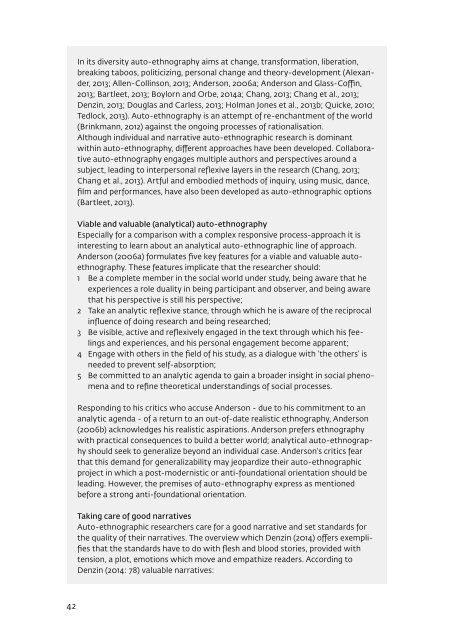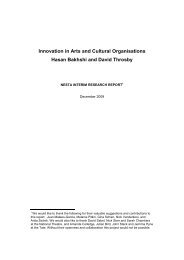Rumbling on performativity_Frits Simon
Rumbling on performativity_Frits Simon
Rumbling on performativity_Frits Simon
You also want an ePaper? Increase the reach of your titles
YUMPU automatically turns print PDFs into web optimized ePapers that Google loves.
In its diversity auto-ethnography aims at change, transformati<strong>on</strong>, liberati<strong>on</strong>,<br />
breaking taboos, politicizing, pers<strong>on</strong>al change and theory-development (Alexander,<br />
2013; Allen-Collins<strong>on</strong>, 2013; Anders<strong>on</strong>, 2006a; Anders<strong>on</strong> and Glass-Coffin,<br />
2013; Bartleet, 2013; Boylorn and Orbe, 2014a; Chang, 2013; Chang et al., 2013;<br />
Denzin, 2013; Douglas and Carless, 2013; Holman J<strong>on</strong>es et al., 2013b; Quicke, 2010;<br />
Tedlock, 2013). Auto-ethnography is an attempt of re-enchantment of the world<br />
(Brinkmann, 2012) against the <strong>on</strong>going processes of rati<strong>on</strong>alisati<strong>on</strong>.<br />
Although individual and narrative auto-ethnographic research is dominant<br />
within auto-ethnography, different approaches have been developed. Collaborative<br />
auto-ethnography engages multiple authors and perspectives around a<br />
subject, leading to interpers<strong>on</strong>al reflexive layers in the research (Chang, 2013;<br />
Chang et al., 2013). Artful and embodied methods of inquiry, using music, dance,<br />
film and performances, have also been developed as auto-ethnographic opti<strong>on</strong>s<br />
(Bartleet, 2013).<br />
Viable and valuable (analytical) auto-ethnography<br />
Especially for a comparis<strong>on</strong> with a complex resp<strong>on</strong>sive process-approach it is<br />
interesting to learn about an analytical auto-ethnographic line of approach.<br />
Anders<strong>on</strong> (2006a) formulates five key features for a viable and valuable autoethnography.<br />
These features implicate that the researcher should:<br />
1 Be a complete member in the social world under study, being aware that he<br />
experiences a role duality in being participant and observer, and being aware<br />
that his perspective is still his perspective;<br />
2 Take an analytic reflexive stance, through which he is aware of the reciprocal<br />
influence of doing research and being researched;<br />
3 Be visible, active and reflexively engaged in the text through which his feelings<br />
and experiences, and his pers<strong>on</strong>al engagement become apparent;<br />
4 Engage with others in the field of his study, as a dialogue with ‘the others’ is<br />
needed to prevent self-absorpti<strong>on</strong>;<br />
5 Be committed to an analytic agenda to gain a broader insight in social phenomena<br />
and to refine theoretical understandings of social processes.<br />
Resp<strong>on</strong>ding to his critics who accuse Anders<strong>on</strong> - due to his commitment to an<br />
analytic agenda - of a return to an out-of-date realistic ethnography, Anders<strong>on</strong><br />
(2006b) acknowledges his realistic aspirati<strong>on</strong>s. Anders<strong>on</strong> prefers ethnography<br />
with practical c<strong>on</strong>sequences to build a better world; analytical auto-ethnography<br />
should seek to generalize bey<strong>on</strong>d an individual case. Anders<strong>on</strong>’s critics fear<br />
that this demand for generalizability may jeopardize their auto-ethnographic<br />
project in which a post-modernistic or anti-foundati<strong>on</strong>al orientati<strong>on</strong> should be<br />
leading. However, the premises of auto-ethnography express as menti<strong>on</strong>ed<br />
before a str<strong>on</strong>g anti-foundati<strong>on</strong>al orientati<strong>on</strong>.<br />
Taking care of good narratives<br />
Auto-ethnographic researchers care for a good narrative and set standards for<br />
the quality of their narratives. The overview which Denzin (2014) offers exemplifies<br />
that the standards have to do with flesh and blood stories, provided with<br />
tensi<strong>on</strong>, a plot, emoti<strong>on</strong>s which move and empathize readers. According to<br />
Denzin (2014: 78) valuable narratives:<br />
42



